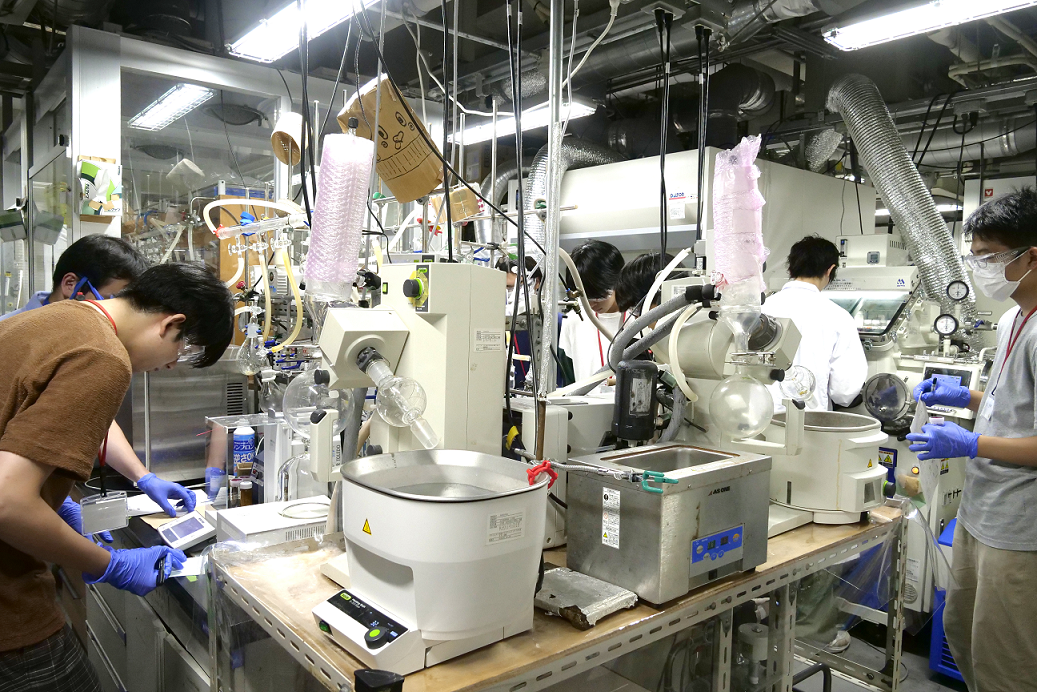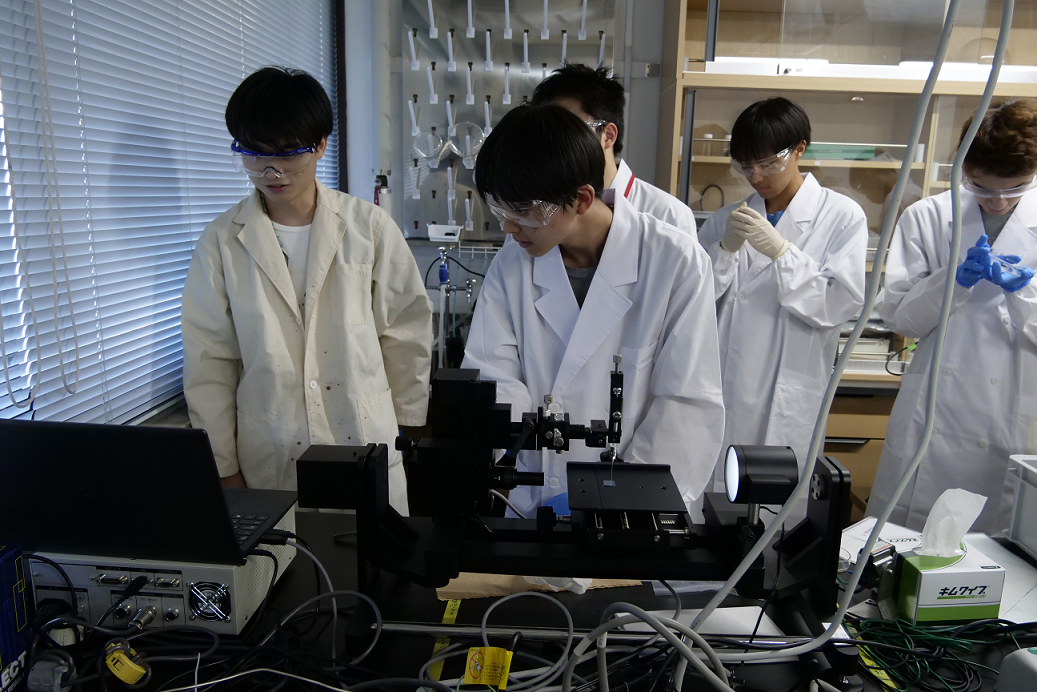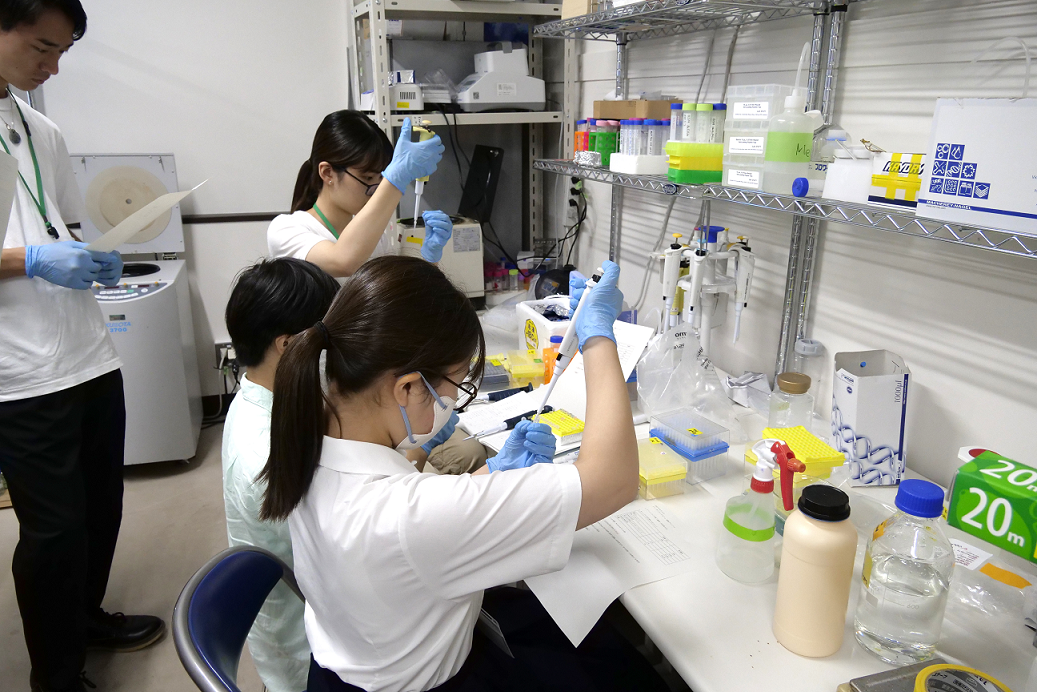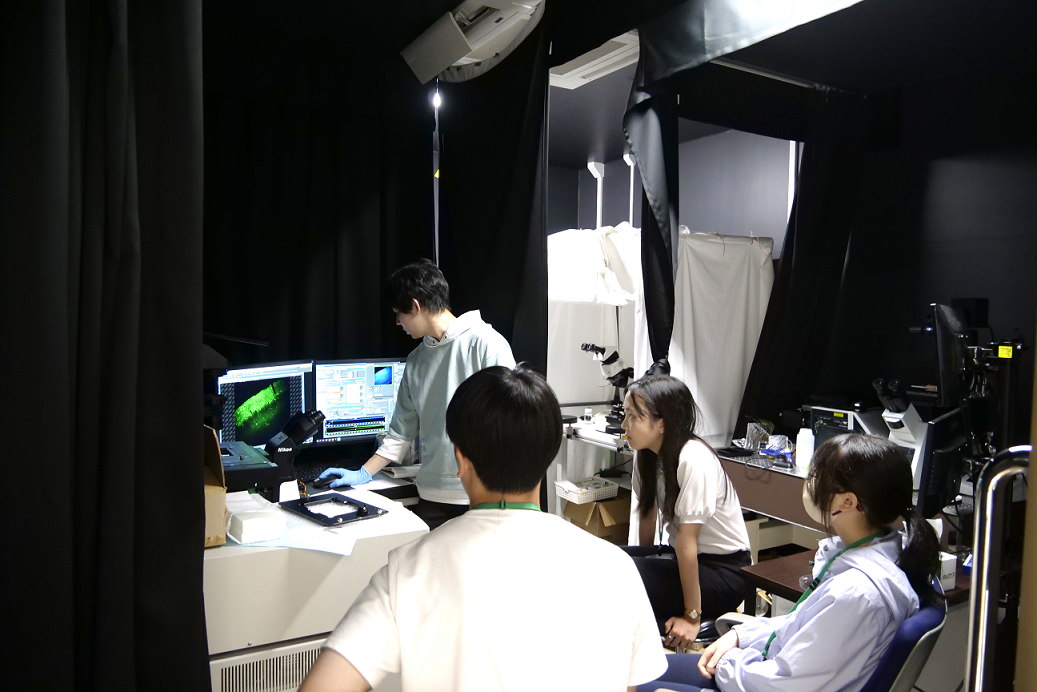Boeing Higher Education Program
BoeingHigherEducationProgram
-
The 75th Komaba Festival Participation Project “Want to Know More about the World of the Faculty of Engineering

The 75th Komaba Festival was held from November 22 to 24, 2024, at the University of Tokyo’s Koma...
November 22, 2024 -
The 34th UTokyo Techno-Science Café’s Report

"Experience Cutting-edge Research in Chemistry, Life Sciences, and Physics." On August 5, 2023,...
August 05, 2023 -
Techno-Science Café’s Extra Edition Report

Techno-Science Café’s Extra Edition Engineering x Gal "Engineering Onimori Technology↑↑ Wireles...
November 03, 2022 -
The 32th UTokyo Techno-Science Café Report

The 32th Techno-science café, “Construction Work Using LEGO Brick” was held on October 19, 2019. ...
October 19, 2019 -
The 31th UTokyo Techno-Science Café Report

The 31st Tokyo University Techno-Science Café, "Useful Surface Science to Know -Science of Wettin...
August 03, 2019 -
The 30th UTokyo Techno-Science Café Report

The 30th Techno-science café, “What is the strength? Let’s make a pasta bridge” was held on Augus...
August 02, 2019 -
The 25th UTokyo Techno-Science Café Report

The 25th Techno-Science Café was held on July 31, 2017. About 30 students, mainly elementary scho...
July 31, 2017 -
The 24th UTokyo Techno-Science Café Report

On July 28, 2017, the 24th Techno-Science Cafe was held at the building 11 of the Faculty of Engi...
July 28, 2017 -
The 23rd UTokyo Techno-Science Café Report

The 23rd Techno-Science Café was held on December 11, 2016. About 20 students mainly from element...
December 11, 2016 -
The UTokyo Techno-Science Café Special Version Report

The 22nd Techno-Science Café, “Design and Manufacturing” was held again on August 10, 2016. About...
August 10, 2016 -
The 22nd UTokyo Techno-Science Café Report

The 22nd Techno-Science Café, “Design and Manufacturing” was held on July 25, 2016. About 30 stud...
July 25, 2016 -
The 21st UTokyo Techno-Science café Report

The 21st Techno-science café, “Let’s fly out to the Space!” was held on March 19, 2016. About 50 ...
March 19, 2016 -
The 18th UTokyo Techno-Science café Report

The 18th Techno-science cafe was held on March 7, 2015, and the theme was "Making Safe Cities: Cr...
May 07, 2015 -
The 14th UTokyo Techno-Science café Report1

The 14th Techno-science Cafe was held on November 10. The theme was "The frontier technology, inn...
November 10, 2013 -
The 13th UTokyo Techno-Science café Report1

The 13th Techno-science café was held on 28th July. The theme was “The batteries and the future o...
July 28, 2013 -
The 13th UTokyo Techno-Science café Report2

Techno Science Cafe ‘The Future of Battery and EV’ was held on 28th, July, 2013 in the University...
July 28, 2013 -
The 11th UTokyo Techno-Science café Report2

On the 24th of March 2013 was held a TechnoScience Café "Engineering Dojo" at the University of ...
March 24, 2013 -
The 11th UTokyo Techno-Science café Report1

The 11th Todai Techno-Science café was held on 24th Mar. This time its theme was “Engineering sch...
March 24, 2013
The 34th UTokyo Techno-Science Café’s ReportAugust 05, 2023 U-Tokyo,Hongo.Tokyo JAPAN

"Experience Cutting-edge Research in Chemistry, Life Sciences, and Physics."
On August 5, 2023, the 34th University of Tokyo Techno Science Café took place. This year, as a special program for high school students, the theme was "Experience Cutting-edge Research in Chemistry, Life Sciences, and Physics." In this event, half a dozen high school students participated in workshops within three fields—chemistry, life sciences, and physics.
「最先端の化学・生命・物理の研究を体験してみよう!」
2023年8月5日、第34回東大テクノサイエンスカフェが開催されました。本年度は高校生限定企画として、「最先端の化学・生命・物理の研究を体験してみよう!」が行われました。「化学」「生命」「物理」の3分野にて、研究室ごとに5、6人の高校生がワークショップを通して最先端の研究を体験しました。
A: "Let's Make Functional Polymer Materials that Interact with Light"
A group of 6 high school students participated in the workshop entitled "Let's Make Functional Polymer Materials that Interact with Light" at Professor Takashi Kato Laboratory, Department of Chemistry and Biotechnology. At the beginning of this workshop, Assistant Professor Takeshi Sakamoto from Takashi Kato Laboratory gave a lecture on the "liquid crystals" that would be used in the experimental section. He explained the world of liquid crystals related to functional polymer materials. High school students may not be familiar with liquid crystals. Liquid crystals are used in a wide variety of fields, such as TV and cell phone display screens, and high-strength fiber and films. The students enjoyed and tried their best to understand the topics even though they were not familiar with them.
A:「光と相互作用する高分子機能素材をつくろう」
化学生命工学専攻 加藤隆史教授の研究室では、「光と相互作用する高分子機能素材をつくろう」というテーマでワークショップを行い、6名の高校生が参加しました。実験の前に、加藤隆史研究室の坂本健助教が今回の実験で用いる液晶に関する講義を行いました。高分子機能素材に関連する「液晶」の世界についての解説の講義を行いました。高校生にとって「液晶」は馴染みのない言葉だったと思いますが、テレビや携帯のディスプレイ、強い繊維やフィルムなど身の回りのさまざまなところで活躍しています。慣れないながらも、楽しみながら一生懸命に理解しようとする生徒たちの前向きな姿勢を感じました。
After the lecture was over, the students moved to the laboratory and started to do experiments. First, we prepared the typical liquid-crystalline molecules to observe the microstructure of these liquid crystals with a polarizing optical microscope. An evaporator is used to dry molecular samples. The students seemed surprised by this unfamiliar instrument. While waiting for drying of the samples, the students prepared functional polymer materials that exhibited structural color induced by the ordered structures of liquid crystals. They had difficulties with mixing the highly viscous materials. However, they enjoyed the vivid shades of the structure’s color. 講義が終わると実験室に移動し、実験を開始しました。まず、ミクロな「液晶」の構造をみることができる偏光顕微鏡観察を行うために代表的な液晶分子の調製を行いました。分子サンプルの乾燥を行うにはエバポレーターという機器を用いますが、生徒たちは見慣れない機器に驚いている様子でした。サンプルの乾燥を待つ間に、「液晶」のもつ秩序構造に由来した構造色を示す高分子機能素材の作製を体験してもらいました。生徒たちは粘性の高い材料を混ぜるのに苦労していましたが、構造色が見えるとその鮮やかな色を楽しんでもらえたようです。
Finally, the students observed the liquid-crystalline molecules using a polarizing optical microscope. They were surprised at the behavior of the liquid-crystalline molecules that showed various beautiful textures depending on the temperature. We hope that this workshop could help the high school students to choose their career paths by stimulating their interest in engineering and chemistry. (Department of Chemistry and Biotechnology, Takahiro Mikami, D1) 最後に、偏光顕微鏡を用いて液晶分子を観察してもらいました。温度によって、様々な美しい模様を示す液晶分子の挙動に驚いていました。今回のワークショップをきっかけに、工学や化学という学問分野に興味をもって、高校生の進路選択の助けになることができたなら幸いです。(三上 喬弘:化学生命工学専攻 D1)
B: "Experience the Power of Fluorine"
Under the collaboration of the Fluorine Organic Chemistry Lab and the Interfacial Molecular Engineering Lab (led by Project Professor Daisuke Kawaguchi and Associate Professor Yoshimitsu Ito), the topic "Experience the Power of Fluorine" was explored.
After receiving lectures on the properties of fluorine-based materials and the principles of measurement, the students engaged in practical activities. They performed the deposition of fluorine-based polymer films and measured contact angles. After that, they were given a tour of both labs, where they were introduced to the experimental facilities and measurement instruments.
B:「フッ素の力を体験してみよう」
化学生命工学科のフッ素有機化学、分子界面工学研究室の合同グループ(担当:川口 大輔 特任教授、伊藤 喜光 准教授)では「フッ素の力を体験してみよう」というテーマで実施しました。
参加した高校生たちは、フッ素系材料の性質や測定原理についての講義を受けた後、実際にフッ素系ポリマーの成膜と接触角の測定を行いました。そのあと、両研究室の見学を行い実験設備や測定機器の説明を受けました。
Following the lessons on the properties of fluorine and the methods of measurement, the students proceeded to practice creating thin films of fluorine-based polymers and measuring their water-repellent and oil-repellent characteristics. The process involved stretching solutions of fluorine-based polymers into thin films. The water and oil repellency of these films was then measured and compared with reference materials such as polystyrene, polyethylene terephthalate, and silicon wafers. This analysis demonstrated quantitatively that fluorine-based polymers exhibit notably high water and oil repellency in comparison to the reference materials. The workshop concluded with a discussion on the factors underlying the water and oil repellency of fluorine-based polymer surfaces. It was emphasized that the reasons behind this characteristic are not fully understood at present, shedding light on the intricacies of chemistry and providing insight into the kind of inquiries pursued at the university level.
フッ素がどのような性質を持っているか、またその性質をどのように測定するかについて学び、フッ素系ポリマーの成膜と撥水・撥油性(どれだけ水や油を弾くか)の測定を実際に行いました。
フッ素系ポリマーを溶かした溶液を薄く伸ばし膜を作成しました。その後、作成したフッ素系ポリマーの膜と比較対象であるポリスチレン、ポリエチレンテレフタラート、シリコンウェハーの撥水・撥油性を測定しました。比較対象に比べて、フッ素系ポリマーは高い撥水・撥油性を持つことを数値で確かめることができました。最後にフッ素系ポリマー表面が撥水性・撥油性を示す要因について考察しました。なぜフッ素系ポリマーが撥水・撥油性を示すのかは未だに解明されていない部分もあり、その面白い性質に触れることで、化学の奥深さや大学での研究内容について理解を深める機会となったことでしょう。
The students had the opportunity to tour the research labs and closely observe experimental apparatuses and measurement devices. This experience likely provided them with a clearer understanding of the research environment within a university setting.
(Department of Chemistry and Biotechnology, Misato Akamatsu, M1)
研究室見学では、実験装置や測定機器を近くで見て回りました。大学の研究環境についてより明確なイメージを持ってもらえたのではないかと思います。
(赤松 美里:化学生命工学専攻 M1)
C: "Let's take a snapshot of the workings of molecules that protect the body"
We in Okamoto Laboratory participated with the title "Let's take a snapshot of the workings of molecules that protect the body" on the subject of life.
In the Okamoto Laboratory, recently, since protein degradation has been attracting much attention as a next-generation research topic in the pharmaceutical industry, we focused on the principle of protein degradation and conducted experiments and evaluations on protein-protein interactions using ubiquitin, which is considered important in proteolysis, and proteins called shuttle factors, which determine the proteolytic pathway. The high school students actually performed the experiments and evaluations themselves. This time, since we used laboratory equipment and devices that are not usually used in high school classes, we could see that the students enjoyed conducting the experiments even though they struggled with them.
C:「体を守る分子の働きをスナップショットで捉えてみよう」
我々岡本研究室では生命を題材として、「体を守る分子の働きをスナップショットで捉えてみよう」というタイトルで参加しました。
岡本研究室では、近年タンパク質分解が医薬品業界で次世代の創薬技術として大きな注目を集めていることから、タンパク質を分解する原理について着目し、タンパク質分解において重要とされるユビキチンおよび、タンパク質分解経路を決定づけるシャトル因子と呼ばれるタンパク質を用いたタンパク質-タンパク質相互作用に関する実験および評価を、実際に高校生に行ってもらいました。高校の授業では普段使わないような実験器具や装置を使うことが多かったため、苦戦しながらも楽しんで実験を行っていることが伝わってきました。
Finally, a lecture on protein basic chemistry and protein degradation was given by assistant Professor Furuhata of Okamoto Laboratory. I think this event was a valuable experience for high school students to learn about the wonders of both chemistry and life, and it was a great opportunity that will motivate them in the future.
(Department of Chemistry and Biotechnology, Taiki Uno, D1)
最後に、岡本研究室の古畑助教授にタンパク質基礎化学やタンパク質分解に関する講義を行いました。今回のイベントは高校生たちにとって、化学と生命の両方の素晴らしさを知る貴重な経験となり、今後のモチベーションにつながる大きな機会になったと思います。(宇野 大輝:化学生命工学専攻 D1)
D: “Experience the stimulation of neural networks”
In the Neurobiology Lab, we observed responses to synaptic stimuli within neurons which express fluorescent sensors for calcium ions and glutamate. Utilizing a high-speed fluorescence microscope, we monitored real-time changes in fluorescence intensity in neurons upon electrical and chemical stimulation, as well as the intricate neural circuits formed on a glass plate. The participants were surprised at the rapid propagation of neural activity, and how the morphology of organelles was much different from what is depicted in textbooks.
Furthermore, we observed immunostained mouse brain slices using confocal microscopy. This observation allowed us to vividly see how axons are bundled together and connect left and right sides of the brain.
We hope that these two observations – the formation of neural circuits on a glass plate and the actual axon elongation in the mouse brain – became a good opportunity for them to gain a deeper interest in the phenomena of life and biology. (Department of Chemistry and Biotechnology, Tomoka Ishiyama, M1)
D:「神経ネットワークの刺激を体験してみよう」
神経細胞生物学研究室では、カルシウムセンサーおよびグルタミン酸センサーを導入した神経細胞内での刺激応答を観察してもらいました。高速撮影可能な蛍光顕微鏡を活用し、神経細胞がガラスプレート上で形成する複雑な神経回路や、電気刺激・化学刺激に対する神経細胞の異なる応答の様子をリアルタイムで観察しました。神経活動の素早い伝播や、教科書に描かれているものとは全く異なった細胞内小器官の形態に、参加者も驚いているようでした。
さらに、免疫染色したマウスの脳切片を、共焦点顕微鏡を用いて観察しました。この観察により、神経細胞の軸索が脳の片側から束状にまとまり、脳梁を通って反対側へ伸展している様子を捉えることができました。
ガラスプレート上での神経細胞回路形成と実際のマウス脳内での軸索伸長という今回の二つの観察が、生命現象や生物学に対して興味をさらに深めていただくきっかけとなればと思います。(石山 智香:化学生命工学専攻 M1)
E: "Experience the Speed of Light"
In the session "Experience the Speed of Light" by Lecturer Yusuke Ito from the Department of Mechanical Engineering, six high school students participated.
The participants first entered the clean room, wearing special lab coats and shoes, and introduced themselves. Subsequently, Lecturer Ito explained what a femtosecond laser is, and the ultrafast imaging technique called the pump-probe method. Everyone listened with great interest and raised questions about unusual topics as laser processing and the distance light travels in femtoseconds.
E:「光の速さを体験してみよう」
機械工学専攻の伊藤佑介講師による「光の速さを体験してみよう」では、高校1年生から3年生の6名が参加してくれました。
参加者はまず専用の白衣と靴を着用してクリーンルームに入り、自己紹介をしました。その後の講義では、伊藤先生に実験に使うフェムト秒レーザがどんなものであるか、やポンププローブ法という超高速イメージング手法の説明をしてもらいました。みなさん興味深そうに聞いており、レーザ加工やフェムト秒間で光が進む距離といった非日常的な話題に対して疑問をぶつけてくれました。
Continuing, they proceeded to an experiment on wavelength conversion of light using a femtosecond laser and special crystals. They observed how infrared light, which is normally invisible to the naked eye, is converted into visible light. Afterwards, they conducted white light generation by shining the same laser on a sapphire crystal. After a short break, they moved on to an experiment on ultrafast imaging using a different femtosecond laser. First, they adjusted the mirrors in the path of the laser to achieve proper alignment for a camera capture. Using a timing synchronization system, they recorded femtosecond laser processing. By moving an automated stage, the delay time of the light was controlled, and they could observe the process progressing at the speed of light. Alongside the experiments, some of them showed interest not only in how to use the equipment but also in the more complex aspects, such as the theories behind the experimental results. そのままの流れで、フェムト秒レーザと特殊な結晶を用いた光の波長変換の実験へ。通常は目に見えない赤外の光が目に見える光に変化する様子を観察しました。その後、同じレーザをサファイアに当てることで白色光発生を行いました。休憩をはさんで、先ほどとは別のフェムト秒レーザを用いた超高速イメージングの実験へ。まず撮影用のレーザの通り道にあるミラーを動かしてカメラにうまく映るような調整をしました。タイミング同期システムを使ってフェムト秒レーザ加工の様子を撮影しました。自動ステージを動かすことで光の遅延時間を制御し、加工が光の速さで進展していく様子を見ることができました。実験の傍ら、器具の使い方だけでなく実験結果の背景にある理論といった踏み込んだところまで聞いてくれる参加者もいました。
Many participants actively asked questions, creating an enjoyable atmosphere. Although it was not possible to cover all the planned contents due to the lively discussions, we believe that everyone had a great experience. (Department of Mechanical Engineering, Tomohiro Fukui, M1) 積極的に質問をしてくれる高校生が多く、終始楽しい雰囲気で進めることができました。議論が盛り上がって想定していた内容をすべて実施することはできませんでしたが、非常に楽しんでもらえたと思います。(福井 智大:機械工学専攻 M1)
During this event, the participants deepened their understanding of light through experiments such as wavelength conversion, white light generation, and plasma formation. In addition, in the experiment using the pump-probe method, the participants manipulated mirrors and stages themselves to gain a tangible sense of how light propagates within materials and its speed. Through these experiments, they gained insights into how light behaves within substances and its velocity. The participants showed great enthusiasm and curiosity, asking various questions about university studies and research. Through this event, they were able to experience the nature of light through hands-on experiments, acquiring knowledge that is often challenging to grasp through theory alone. (Department of Mechanical Engineering , Qinru Zheng, D1) このイベントでは、波長変換、白色光発生、プラズマ生成といった実験を通じて、光に関する理解を深めました。またポンププローブ法の実験で、参加した高校生たちは自らミラーやステージを操作して光が材料の中で進む過程と速さを実感しました。このような実験を通じて、光が物質内でどのように振る舞うのか、そしてその速さについての洞察を得られたと思います。参加者たちは興味津々で大学での勉学や研究についても、いろいろ質問してくれました。今回のイベントを通して、参加者たちは実際の実験を通じて光の性質を体験し、理論だけでは得難い知識を得られたと思います。(鄭 勤如:機械工学専攻 D1)





